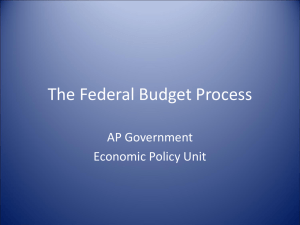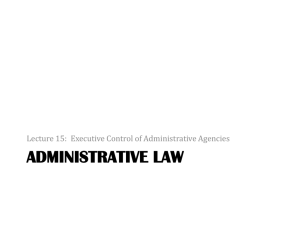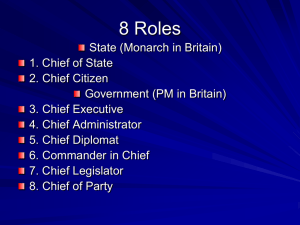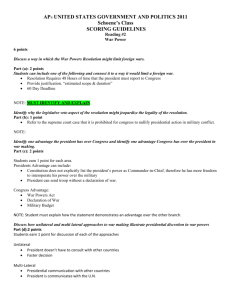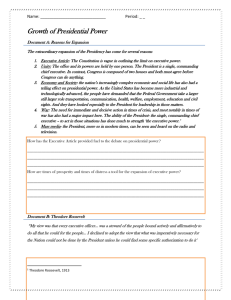The Presidency and the Constitution
advertisement
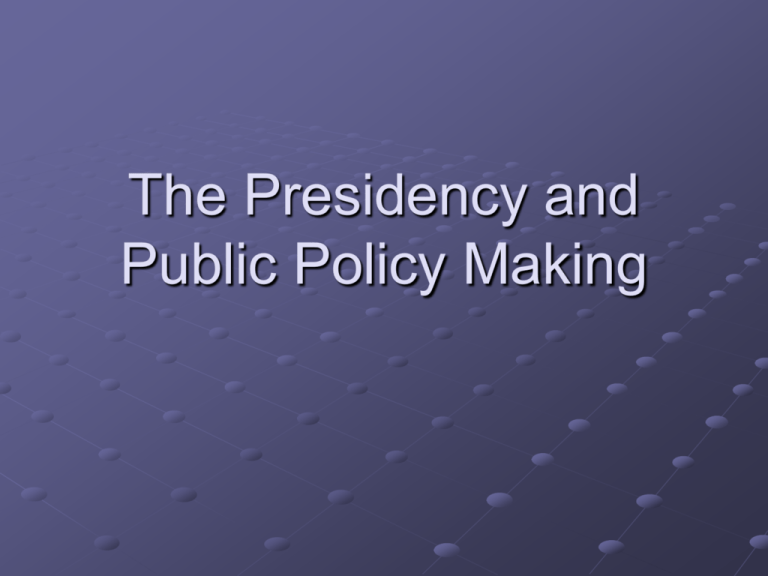
The Presidency and Public Policy Making Historical Overview The framers of the Constitution did not intend to make the president a major domestic policymaker. Article II clearly establishes Congress as having the policymaking power. The Congress is to legislate and the president is to “take care that the laws are faithfully executed.” The president is given authority to recommend legislation that is necessary and expedient. However, nowhere in the constitution is there an expression of intent that the president will be chief domestic policymaker. Yet this is precisely what has occurred. The president is expected by citizens, groups, the parties, Congress, and presidents alike to propose a legislative program and use influence to make sure it is enacted. If the president fails in this regard citizens hold the president accountable through elections, approval, and historical judgments. The framers did not envision the president as chief domestic policymaker, but they did provide the president some policymaking powers. Recommend necessary and expedient legislation Lattitude in the execution of the law. These two prerogatives have evolved as the Constitutional basis of the president’s policymaking role. For the first one hundred years presidents 1) recommended measures, 2) took positions on legislation before Congress, 3) occasionally even drafted bills, but 4) did not formulate a cohesive domestic policy on a regular basis. By the 1880s there was a changing public sentiment toward the role of the federal government in the US system. This changed sentiment was brought on by market competition carried to its extreme, and resulting from the laissez faire policy and hands off approach of the strict constructionist constitution. Government promoted commercialism and industry as a measure to develop the economy. However, “big” business grew bigger and was able in many arenas to dominate markets through monopoly. Business and monopolists were quite arrogant about their price fixing and efforts to monopolize. You might call it nose thumbing when Standard Oil was created by the buying out of 39 independent oil companies, virtually eliminating economic competition. Likewise in the steel industry, the ruthless behavior or Carnegie, Rockefeller, etc. virtually eliminated small steel companies. Similarly in the banking industry, J.P. Morgan attempted to create a banking trust. The railway industry was similarly arrogant, even after having been created by massive public subsidies. Popular calls for change emerged, but Congress, as it is today, was fragmented, dominated by special interests, and lacking in policy leadership. In 1886, Congress passed the Interstate Commerce act to address the problem of rate discrimination by the railroads against farmers. This was during the first Grover Cleveland adminisration (a Democrat). It was amended in early 1887 to prevent the Republican president (Benjamin Harrison) from failing to implement the legislation by placing responsibility for implementation in an independent commission. In 1890 during the Benjamin Harrison administration (a Republican), Congress passed the Sherman Antitrust Act. Harrison signed the legislation. Effectively, however, the Supreme Court gutted these enactments based on a restrictive interpretation of the 10th amendment. The legislation was not used in court cases for some years. William McKinley (1897-1901) was also business friendly, leading to little action to suppress monopoly practices. Beginning with Theodore Roosevelt in 1901 and continuing through Woodrow Wilson, presidential participation in the policymaking process expanded. Roosevelt consulted frequently with Speaker of the House Joseph Cannon. Cannon’s power as Speaker helped Roosevelt get progressive era legislation through Congress. Roosevelt’s legislative program was called the “square deal”. It included legislation dealing with things from the Panama Canal to creating a National Parks Service, to various conservationist measures. Administratively, Roosevelt attempted to push a trustbusting strategy using the Sherman Act, but the Courts restricted his ability to do so. Pure Food and Drug Act of 1906 in reaction to the excesses of the meat packing industry. White Slave Trade Act of 1910- the Mann Act which prohibited the shipment of Women in interstate commerce for the purpose of prostitution and white slavery. This was during the Taft presidency. While he did not have the reputation for doing so, Taft actually continued many of the policies from the Roosevelt administration, including more vigorous efforts at trust busting. Hepburn Act gave the ICC the power to set rates in interstate commerce. Woodrow Wilson expanded the presidential role even further. Wilson was a political scientist. He wrote a book while a professor at Princeton entitled Congressional Government. The book was descriptive, depicting government in the US as primarily Congress centered. The president was depicted as assuming a rather limited policymaking role. Nevertheless, Wilson saw his responsibilities as similar to those of the British prime minister-to propose an integrated set of measures that addressed social and economic problems and then to use personal and political influence to see that they get enacted. Wilson personally helped formulate a legislative program, even drafting some legislation. He also often went across to address Congress. He was the first president since John Adams to personally deliver a state of the union address. Wilson’s legislative program was dubbed by publicists as the New Freedom. It included labor measures, tariff reform, and consumer protection. He introduced legislation that created the Federal Reserve System for the purpose of stabilizing the money system. He also secured passage of the Adamson Act which established the 8 hour work day for Railroad workers. The Clayton Antitrust Act was intended again to reign in monopolies and trusts and made illegal activities such as price fixing, mergers that restricted competition, interlocking directorates, rate collusion, etc. He also oversaw the creation of the Federal Trade Commission Act of 1914 which was intended to regulate anti-trust and consumer protection. This was an independent commission not under the direction of the president. The Supreme Court continued to take a restrictionist view of the expanded role of the federal government that flowed from the progressive era. Gutted the FTC Act, the Clayton Act, etc. as they pertained to anything other than the federal level. A restrictive interpretation of the 10th amendment implied that the federal government did not have the authority to regulate matters in intra-state commerce or to interfere in the economies or affairs of the states. Wilson’s Republican successors, Harding, Coolidge, and Herbert Hoover, did not seek to expand the president’s policymaking role. Their conservative philosophy undoubtedly influenced their conception of a limited presidential role. A return to the normalcy of the 19th century. Nevertheless several important regulatory enactments occurred through this period, reflecting the path of modern technology. The Civil Aeronautics Board and the Federal Aviation Administration. The Federal Communications Commission. Federal Maritime Commission. The depression did more to expand the president’s role than any other single event. The 19th century had seen numerous monetary panics, runs on banks, recessions and mini-depressions. However, in 1929 a major interruption occurred in the market economy. It was of such proportions as to cause panic among the mass public. 9,000 banks failed, and when a bank failed in those days people lost everything they had. GNP fell from $104 billion to $56 billion. Business investment fell by 88 percent. Unemployment grew from 3.2 percent in 1929 to 24.9 percent. 85,000 businesses failed. Wages and salaries dramatically declined. People were literally going hungry. Herbert Hoover took a basically hands off approach to resolving the nation’s economic difficulties. Quote from HH. “The evidence of our ability to solve great problems outside of government action and the degree of moral strength with which we emerge from this period will be determined by whether the individuals and local communities continue to meet their responsibilities. Throughout this depression I have insisted on the organization of these forces through industry, through local government, and through charity, and that they should meet this crisis by their own initiative, by assumption of their own responsibilities. The nation’s governors also generally advocated a hands off approach early in the depression. Let me quote one of them. “There is a tendency and to my mind a dangerous tendency, on the part of the national government to encroach on one excuse or another more and more upon state supremacy. The elastic theory of interstate commerce has been stretched to the breaking point.” Franklin Roosevelt, Governor of New York. Presidential leadership by Franklin Roosevelt addressed many of the problems of the depression. From this point onward, the president was expected to be chief policymaker. Banking Act of 1935- Centralization of the banking system and federal regulation of depository institutions. Federal Deposit Insurance Corporation-Insured bank deposits. Securities and Exchange Commission-regulated the sale of securities. Agricultural Adjustment Act- payments to farmers to control production and reduce acreage and competition, affect prices. National Industrial Recovery Act- fair competition in specifying wages and hours for labor and prices. Civil Works Administration and Civilian Conservation Corpspublic works projects. National Labor Relations Act- relations between management and workers. Social Security Act- old age assistance and disability insurance. Roosevelt actively participated in designing a program for bringing the nation out of the depression. Drafted legislation, fought for that legislation in Congress. When the Supreme Court struck down major components of the New Deal, Roosevelt threatened to “pack” the court with one new justice for every one that opposed the program. Two Cases struck down the New Deal: Schechter Poultry Corporation vs. U.S. (1937) NLRB vs. Jones and Laughlin Steel Company (1937) However, these two cases were reversed after Roosevelt’s threat to pack the Supreme Court. From here on, the locus of policymaking in the new policy making system has been the president. Presidents have been expected to be chief policymakers. They are, however, constrained in their time and attention. There are three demands on presidential attention: 1) Ongoing operations of government, 2) Crisis Management, and 3) Pushing the President’s personal agenda, which may be rooted in campaign promises. Because of these demands, the ability of the president to personally set the policy making agenda for the system is limited. Nevertheless, every president from Truman through Clinton has presented to Congress a legislative program. When Eisenhower in his first year failed to present one, he was soundly criticized so that he did submit one every other year. Presidents Roosevelt through Eisenhower expanded the role of the federal government in the economic sphere. Kennedy and Johnson expanded the role of the federal government to include social welfare and civil rights measures. Quality of life issues. Medicare and Medicaid. Civil Rights Act of 1964. Equal Pay Act of 1963. Age Discrimination in Employment Act of 1965. National Highway Traffic Safety Act of 1965. Later, during the Nixon administration this social agenda was expanded under a Democratic Congress, but with the approval of the president. EPA, OSHA, CPSC, NRC, Energy Department, OSM. The 1960s were a period of unbridled prosperity and economic development. However, the weakening of the economy beginning during the early Nixon administration produced new constraints. Higher inflation, greater unemployment, declining productivity, increasing foreign competition, and decreasing natural resources restricted the ability of the federal government to address both economic and social problems. The public’s mood also shifted through this period into a more restrictive mode. Presidents from Carter through Clinton actually attempted to shrink the role of the federal government in affecting the economy and in the area of social welfare. However, government grew substantially during the Carter through Bush I presidencies. Indeed, the federal debt grew enormously during the Reagan administration. Only Clinton was successful in shrinking the size of the federal government, both in terms of personnel and government expenditures as a proportion of GDP. The size of the federal government has expanded dramatically during the George W. Bush administration, both as a function of the new Department of Homeland security, increased defense spending, and the recent expansion of Medicare benefits. It would appear that the current administration lacks a sense of fiscal constraint from expanding deficits and debt. These are matters that a future administration will be forced to deal with, just as the current president Bush’s father was forced to do following the Reagan administration. The OMB and Presidential Policymaking Presidents require staff support in order to be chief policy makers. If policies cost money they need advice from financial experts, in the OMB and Treasury Department. If policies require a policy strategy they need advice from policy experts. Much of this support comes from the OMB and the line agencies. Other such support comes from the Office of Policy Development within the White House. Exercising central clearance-Presidents in the modern era have exercised clearance over initiatives originating anywhere in the executive branch. This was initially done in the Bureau of the Budget beginning in the 1930s. The OMB since 1970 has performed this role. Any policy proposal emanating from the executive branch that the OMB believes conflicts with the president’s policy is not sent across to Congress. In making their judgments the OMB uses presidential campaign statements, major speeches and reports, and special messages to Congress. If there is uncertainty, the White House is consulted directly. Decisions are usually final. Presidents find this process to be useful, because it produces coherent policy and centralized leadership. It also takes some of the burden off the president in assuring coherent policy. Indicates those proposals with the president’s approval, Makes departments and agencies aware of the president’s policy Helps resolve interagency disputes. Congress also finds the process to be useful since it limits the number of executive branch proposals to be considered. From the standpoint of the departments the clearance process represents a constraint and the OMB is the policing agency. Operates today in much the same manner as it always has. However, central clearance under OMB is far more politicized than it was prior to 1970. Policy must be consistent with the prevailing party ideology, and not just the president’s preferences. This increased politicization of the clearance process may also have led to illegalities. During the 1970s the NHTSA had conducted formal rulemaking procedures to require passive restraints for all auto manufacturers by 1982. The Reagan administration under the central clearance process nullified this NHTSA rule. The Supreme Court ruled that this was an unconstitutional denial of due process. The Reagan administration had to go through “contrived” rulemaking to nullify the rule, which it ultimately did. In addition to exercising central clearance for the president, OMB performs a coordinating function. It solicits and summarizes recommendations from the executive branch on legislation that has passed both houses of Congress, but not been signed by the president. These may form the basis for presidential vetoes. After legislation has been passed by both houses, OMB circulates copies of the legislation to all executive branch units that are affected, as well as the White House. The departments and agencies are given 48 hours to make a recommendation to the president. Their recommendations, accompanied by supporting arguments and evidence, are then summarized by OMB, which adds a recommendation of its own and sends the entire file to the White House within the first 5 days of the 10 days the president has to sign or veto the legislation. A similar process designed to solicit the views of White House aides was begin in 1955. Today, presidential decisions to sign or veto pending enactments receive the advice of a plethora of individuals with vast technical knowledge and diverse perspectives. Of all the participants in the executive branch, presidents are most influenced by OMB. OMB recommendations to approve of legislation are almost always accepted. On the other hand, OMB advice to veto may be ignored if there is significant political pressure from other fronts. Cole and Wayne find that OMB recommendations to veto are followed only slightly more than 50 percent of the time. The role of the OMB was extended during the Carter administration by the Paperwork Reduction Act. A new unit was established in OMB, the Office of Information and Regulatory Affairs, to administer the legislation. Initially its function was to eliminate excessive reporting requirements by federal regulatory agencies. Within one month after assuming office the Reagan administration imposed an additional function on this office. EO 12291 under Reagan meant that all new regulations had to be subjected to regulatory review and cost benefit analysis. In 1985, Reagan extended these duties to include all prerulemaking activities of the Departments and agencies. In response, agencies diminished the number of new rules. The number began to increase during the Bush administration. The federal bureaucracy is required to analyze the costs and benefits of any new rules estimated to have an impact of greater than $100 million. These are called major rules. The Clinton administration continued to use OIRA to monitor agency regulations. Clinton actually expanded the use of regulatory review by making the definition of major rules more inclusive. Clinton also issued an executive order in 1993 requiring agency officials to disclose their contacts with interest group representatives and requiring groups to issue their opinion in writing on new regulations.The Clinton administration charged Al Gore with coordinating its regulatory priorities and agendas. The current Bush administration has continued the regulatory review process, claiming to increase its stringency and to diminish the flow of new regulations from administrative agencies. Regardless, as a result of OMB and regulatory oversight the president extends influence over bureaucratic policymaking in the executive branch. This circumvents the “iron triangle” relationships which existed in the 80s. The Domestic Policy Council and the President’s Annual Legislative Program Satisfies the president’s need to articulate a program. Satisfies Congress’s need to have an agenda upon which activities are focused. During the Truman and Eisenhower administrations BOB coordinated the process through its annual budget review. Collected ideas and sent to the White House. The State of the Union address became the vehicle for presenting policy proposals to Congress. The president’s program tended to have a departmental orientation prior to the 1960s. With Kennedy and Johnson it tended to take on more innovative directions. Resolving public problems that had heretofore been ignored by the departments and executive branch. Kennedy and Johnson bypassed OMB and set up task forces of intellectuals, party activists, business and labor leaders, experts, and political strategists in formulating a legislative agenda. Under Kennedy and Johnson the number of task forces increased, but their recommendations to the president were secret. The president’s domestic policies were first coordinated by the Domestic Policy Office within the White House beginning in 1965. The Domestic Policy Office was charged with staffing Johnson’s task forces and then reviewing their recommendations and converting them into a legislative format, and executive order, or a proposed departmental regulation. Nixon institutionalized this arrangement by creating a Domestic Council composed of cabinet secretaries and supporting staff. Organized as a separate unit in the EOP, the staff quickly assumed dominance over the process. All domestic policy documents passed through this office which was supervised by John Erlichman during the Nixon administration. The Domestic Council designs and coordinates the president’s policies. The size of these staffs have varied considerably depending on how active the president was in promulgating new policies. Ford reduced the role of the Domestic Council, but Carter resuscitated it. Reagan again reduced the role of the Domestic Council to more or less administrative tasks, since he had no intention of proposing new programs, but wanted to do away with some old ones. Bush had no well defined domestic policy agenda and did not rely heavily on the Domestic Council. However, Clinton did and revived this system. Under President Bush, the Domestic Policy Council oversees major domestic policy areas such as education, health, welfare, justice, federalism, transportation, environment, labor, and veterans' affairs. The Office of National AIDS Policy (ONAP), the Office of National Drug Control Policy (ONDCP), and the Office of Faith-Based and Community Initiatives (OFBCI) are also affiliated with the Domestic Policy Council. The Domestic Policy Council's formal membership includes the cabinet Secretaries and Administrators of federal agencies that impact the issues addressed by the DPC. Models of Presidential Policy Making Top-Down-The president is the innovator. The president perceives and defines the public problem. Collects information, develops proposals, designs a legislative or administrative strategy, and exercises personal persuasion to accomplish a policy goal. President mobilizes public, interest group, and legislative support. Example: Clinton and health care. Clinton made campaign promise on reforming health care. Assigned Hillary and a team of policy experts to formulate recommendations, designed a bill which went to Congress where the president put substantial energy into passage. It failed as a result of a massive lobbying campaign by the health care industry and opponents in Congress. This case illustrates the peril of the top-down approach. Bottom-Up- The public or groups perceive and define a public problem. Group aggregation and mobilization occurs. This brings it to the attention of the president. Information and proposals may flow from groups or the president. Basically the president is in a responsive mode in pushing the policy. Example: Environmental politics in the 1960s. Disasters in Donora, Penn. Congressional limited responses under Muskie. Nixon and one-upmanship during 1970. Eventual passage of the clean air act of 1970. Stochastic Response Model-Focusing events shift attention to the policy, and the president responds in a sort of crisis mode. Example: Bush administration response to 9-11. Here there was no plan by the administration, or pressure from interest groups to place more emphasis on homeland security. The president was forced by virtue of events to respond to the crisis in a way that would produce a greater sense of security in America. Question: Would it have mattered who the president was following 9-11 with regard to the nature and magnitude of the response? It could be argued persuasively that any president would have responded strongly to 9-11, because the perception of crisis forced them to. Evolution of the Plural Presidency Prior to the 1970s the executive and BOB were relatively oblivious to interest group influence. They operated in a relatively closed style, with little public visibility. Presidential advice was relatively impermeable to external influence. One response to Watergate and the closed Nixon White House was to open up White House policy making to the public and pluralistic forces. Plural presidency concept. Following Watergate, lobbyists began to contact the OMB and White House directly. The White House began in turn to use interest group and community leaders to help build support coalitions. By the mid-70s a separate office had been established in the White House to accomplish the objective of communicating with interest groups. The Office of Public Liason. Presidents use interest groups to legitimize their policy positions, improve their political status, build coalitions, and extend representation and access to groups. Positive aspect of the plural presidency. Extends representation to a more micro level. Negative aspect is the “revolving door.” Or, White House officials leaving and going to work for private interests. Innuendos of past favors. Michael Deaver, deputy chief of staff for Reagan during his first term left the administration to become a lobbyist. Later he was accused of violating a federal conflict of interest law that restricts contracts to former insiders. To avoid the appearance of impropriety, President Clinton requested that appointees take a pledge not to have contacts with those with whom they worked in government for a period of 5 years after they left public service. President Bush has abandoned that policy. Building an Agenda Domestic policymaking, because of the massive responsibilities, requires that the president limit the number of items on the agenda, prioritizing those items that achieve the president’s agenda, and cycling them more effectively over the congressional calendar. Recall the bank account versus political investment model. Limiting the number of items on the president’s agendaThink of the president’s agenda as a space limited in volume in which only a few issues can attain prominence. This space includes foreign policy, the symbolic presidency, as well as domestic policy. As new issues arise, they must push old issues out of the space. Issues come and go as a function of the personal dimension the president brings to office (Johnson and civil rights and poverty, Carter and the energy crisis, Reagan and taxation, reducing the size of government, Clinton and economic stimulus package, budget reform, and health care). Bush II and … Issues also come and go as a function of exogenous events (Three Mile Island, Assassination attempt or Kansas City bombing and gun control, 9-11 and domestic security). Wise presidents limit the number of items occupying the restricted agenda space. Helps presidents set the tone and pace of the debate. Helps maintain public focus on presidential initiatives. Contributes to the perception that they are in charge. Negative side to limiting agenda is that some will say that the administration is not addressing the most important problems. Cycling political issues- The administration’s priorities must be cycled over the course of the congressional calendar. They cannot wait to make initial proposals and cannot also inundate Congress with proposals. Moving quickly is important: electoral cycles, departmental pressures, and public moods tend to decrease presidential influence over time. Presidential discretion in cycling policy issues is limited by 1) election campaigns, 2) the range of policy alternatives being considered, 3) the political environment, and 4) the type issue. Election campaigns may move new issues into the limited space and take old issues off. Range of alternatives considered. If there is no available alternative, it makes little sense to push an issue. Abortion is an example. Political environment shapes what might be acceptable policy to address and appropriate solution. Type issue-presidents have influence over some issues more than they do on others. More influence over tax policy than over agriculture policy where interest groups are influential. Macro versus subsystem politics. Presidents must package their domestic program strategically by manipulating image and coopting as much support as possible. As strategists, presidents must discern the important issues from the unimportant domestic issues. Success is more likely if an issue is widely perceived as important and there is consensus on the solution. Presidents, as representatives of the general electorate, need to maintain a national perspective. An ideological framework may be useful, but it is more important to frame issues in terms of the national interest. Presidents also need to maintain a long range perspective. Incrementalism versus long range planning. Congress tends to make policy that is incremental. The president must focus that incrementalism toward a long range goals.



